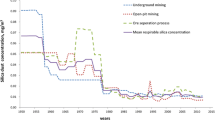Summary
To provide a scientific basis for determining the health surveillance period of dust-exposed workers, data of a retrospective cohort study was re-analyzed with emphasis on natural course of silicosis. 33640 workers exposed to silica dust who were employed for at least 1 year from 1972 to 1974 in twenty Chinese mines or pottery factories were included as subjects, and were followed up till December 31, 1994. The cohort included subjects from 8 tungsten mines, 4 tin mines and 8 pottery factories. Our results showed that the mean latency of silicosis, for all the cases of the cohorts, was 22.9±9.8 y. 52. % of silicosis was diagnosed approximately 9.1±5.7 y after the dust exposure had ceased. The progression rates of silicosis from stage I to II and from stage II to III were 48.2% and 18.5%, and the duration was 4.1±0.2 and 6.8±0.2 y, respectively. The survival times of silicosis stage I, II and III, from the year of diagnosis to death, were 21.5, 15.8 and 6.8 years, respectively. There was 25% of the silicosis patients whose survival time was beyond 33 y. The mean death age of all silicosis cases was 56.0 y. The death age increased to 65.6 y in the middle of 1990s. Among dust-exposed workers, subjects who became suspected case (0+) accounted for 15.0%. 48.7% of the suspected silicosis cases developed to silicosis, and the average year from the time of being suspected of the disease of the first stage of silicosis was 5.1 y. The natural characteristics, as mentioned above, varied with different mines and factories. We are led to conclude that silicosis is chronic in nature, but progress quickly. As a serious occupational disease it significantly reduces the life span of exposed workers. The study of its natural history is of importance for the development of health surveillance criteria for dust-exposed workers.
Similar content being viewed by others
References
Rice F L, Stayner L T. Assessment for silicosis risk for occupational exposure to crystalline silica. Scand Work Environ Health, 1995,21(2):87–90
Chen W, Zhuang Z, Attfield M Det al. Exposure to silica and silicosis among tin miners in China: exposure-response analyses and risk assessment. Occup Environ Med, 2001,58(1):31–7
Cocco P, Rice C H, Chen J Qet al. Lung cancer, silicosis in Chinese mines and factories: the modifying role of other workplace lung carcinogens. Am J Ind Med, 2001,40(6):674–82
NIOSH Criteria for a recommended standard. Occupational exposure to respirable coal dust crystalline silica. US department of health services. Washington Government printing office; D.C., 1995. 4–5, 95. 143
BBG, Gefahrstoffe 2003. Wiesbaden Universum Verlagsanstalt GmbH KG: 2003.
Ministry of Health, People's Republic of China. Roentgenodiagnostic criteria for pneumoconiosis (GB5906-86). Beijing: Chinese Academy of Preventive Medicine (Chinese), 1986. 1–4
Guidelines for the use of ILO international classification of radiographs of silicosis. Rev. ed. Geneva; Switzerland: International Labour Office, Occupational Safety and Health Series No. 22 (Rev.).
Ministry of Health, Peoples' Republic of China. National silicosis epidemiology investigation from 1949 to 1986 1st ed. Beijing:Beijing Medical University and Union Medical University Press (Chinese), 1992, 9, 33–44
Rosenman K D, Reilly M J, Kalinowski D Jet al. Silicosis in the 1990s. Chest, 1997, 111/3:779–786
Finkelstein M M. Silicosis surveillance in Ontario: detection rates, modifying factors, and screening intervals. Am J Ind Med, 1994, 25(2):257–66
Hnizdo E, Sluis-Cremer G K. Risk of silicosis in a cohort of white South African gold miners. Am J Ind Med, 1993, 24(4):447–57
Lee H S, Phoon W H, Ng T P. Radiological progression and its predictive risk factors in silicosis. Occup Environ Med, 2001, 58(7):467–71
Ogawa S, Imai H, Ikeda M. A 40-year follow-up of whetstone cutters on silicosis. Ind Health, 2003, 41 (2):69–76
Author information
Authors and Affiliations
Additional information
YANG Haibing, man, born in 1967, M.D., Ph.D.
This project was supported by a grant from the chinese Center for Disease Control and Prevention (CDC) (No. 2001BA704B04).
Rights and permissions
About this article
Cite this article
Haibing, Y., Lei, Y., Junyue, Z. et al. Natural course of silicosis in dust-exposed workers. J. Huazhong Univ. Sci. Technol. [Med. Sci.] 26, 257–260 (2006). https://doi.org/10.1007/BF02895832
Received:
Issue Date:
DOI: https://doi.org/10.1007/BF02895832




